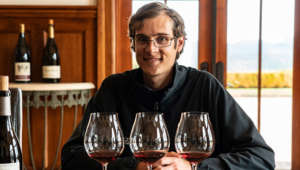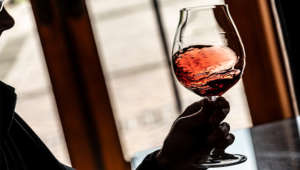This may have happened to you: You’re tasting wine with friends (who you suspect know more about wine than you do) and they are exclaiming over aromatics and flavors that you just don’t detect. “Nice minerality,” they say. “I’m getting forest floor, and a little tobacco,” they say. And you’re thinking, “All I taste is wine!” You feel like you’re missing out (and maybe you are), but take heart.
Like any other ability, your palate can be cultivated. Heredity plays a role, according to Assistant Winemaker Andrew Belzer, but, as with most things, your palate will improve with practice. And let’s face it, there are worse fates.
Much has been written about how to taste wine, but there’s no substitute for sitting down for a tutorial with an experienced winemaker. Here are some insights Andrew offered recently as he discussed his own wine appreciation journey.

How to Cleanse Your Wine Palate
“How-to” articles on winetasting often start with the look of the wine in the glass – the color, clarity and “legs,” but Andrew likes to start with smell. Otherwise, he says, it’s like judging a book by its cover. In fact, he’s tried the experiment of tasting wine in a black glass and found that it was harder to guess if a wine was red or white than he had anticipated. (He may even have guessed wrong once or twice but we can neither confirm nor deny those reports.) Looking at color first can be misleading with Pinot Noir in particular because it isn’t the deep crimson we might associate with California reds but is rather brick red in color.
Andrew recalls taking a class at Fresno State University from the venerated late wine scholar Dr. Ken Fugelsang, who would develop his students’ sense of smell by sending them into the hallway and challenging them to identify what they smelled. “The sense of smell is one of the more sensory aspects of wine,” Andrew discovered. “Wine really starts with smell. To this day I still try to identify smells no matter what my surroundings.”
One reason we swirl wine in the glass is to release aromatics. (Some people like to look for the wine legs, sometimes called “tears of wine,” that form on the inside of the glass but contrary to popular belief this is not a sign of quality or of sugar content. Rather, it simply tells you that the drink contains alcohol and that it’s evaporating. Thicker and slower legs can indicate a higher alcohol level, nothing more.)

The primary aromas will likely be fruit and floral notes, followed by secondary “esters” that are short-lived and may impart a banana smell, followed by tertiary aromas that are found in wines that are aged in oak – reds and Chardonnay.
Before Tasting Wine
Before tasting the wine, do multiple sniffs and see what you can detect. Then taste. “You’ll get flavors you can’t smell,” Andrew says. Look for overall mouthfeel – weight and viscosity corresponds with tannins, or acids. Note your first impression. Taste through your teeth and let it hit the tongue. “It happens quickly,” Andrew notes. How does it sit on your tongue? Are the tannins soft and supple, or chalky and bitter? Acid comes at the finish; you want the acid to linger. Higher acid makes wines show their brighter side. The proper level of acid gives wine the perception of being round and full-bodied.

Andrew’s own tasting breakthrough came when he was a junior in college and tasted a 1982 St. Julien Grand Cru, a Bordeaux red. “There was wet stone, minerality, fresh humidor, ground right after the rain, black currant, cassis,” Andrew recalls. College was a wonderful time to explore wine, Andrew found, but it’s never too late to get started.
Here are some hints for becoming a good Wine taster:
- Practice.
- Do blind tastings. Consider an exercise where you blind-taste three wines of the same varietal where two are the same and one is from a different producer. (Winemakers actually use this technique to detect possible flaws in their wines.) Another technique is to add unlabeled wine standards, or extracts – made from mushroom or sage, for example – to a glass of wine and try to identify them.
- Use black glasses when tasting. This challenges your smell and taste.
- Given how important the sense of smell is to tasting, don’t wear heavy perfume or cologne.
- Group tastings are fine but develop your own thoughts first. At one tasting Andrew was told in advance to look for coconut notes and now that’s all he can taste when he drinks that one. “We’re very impressionable,” he notes. Don’t discuss the wine until everyone is done tasting.
- Cleanse your palate, but water doesn’t cut it. Use a neutral cracker or ginger snaps and sparkling water; the bubbles help reset your palate.
- Be careful not to drink too fast or too much because your sensory acuity will decline.
The big question, of course, is how to finish the taste. To spit or to swallow is a taster’s dilemma. Andrew’s recommendation? “Spit until you find the one you really like and enjoy a glass of it.”
Now that’s good advice. Learn more with King Estate today.
